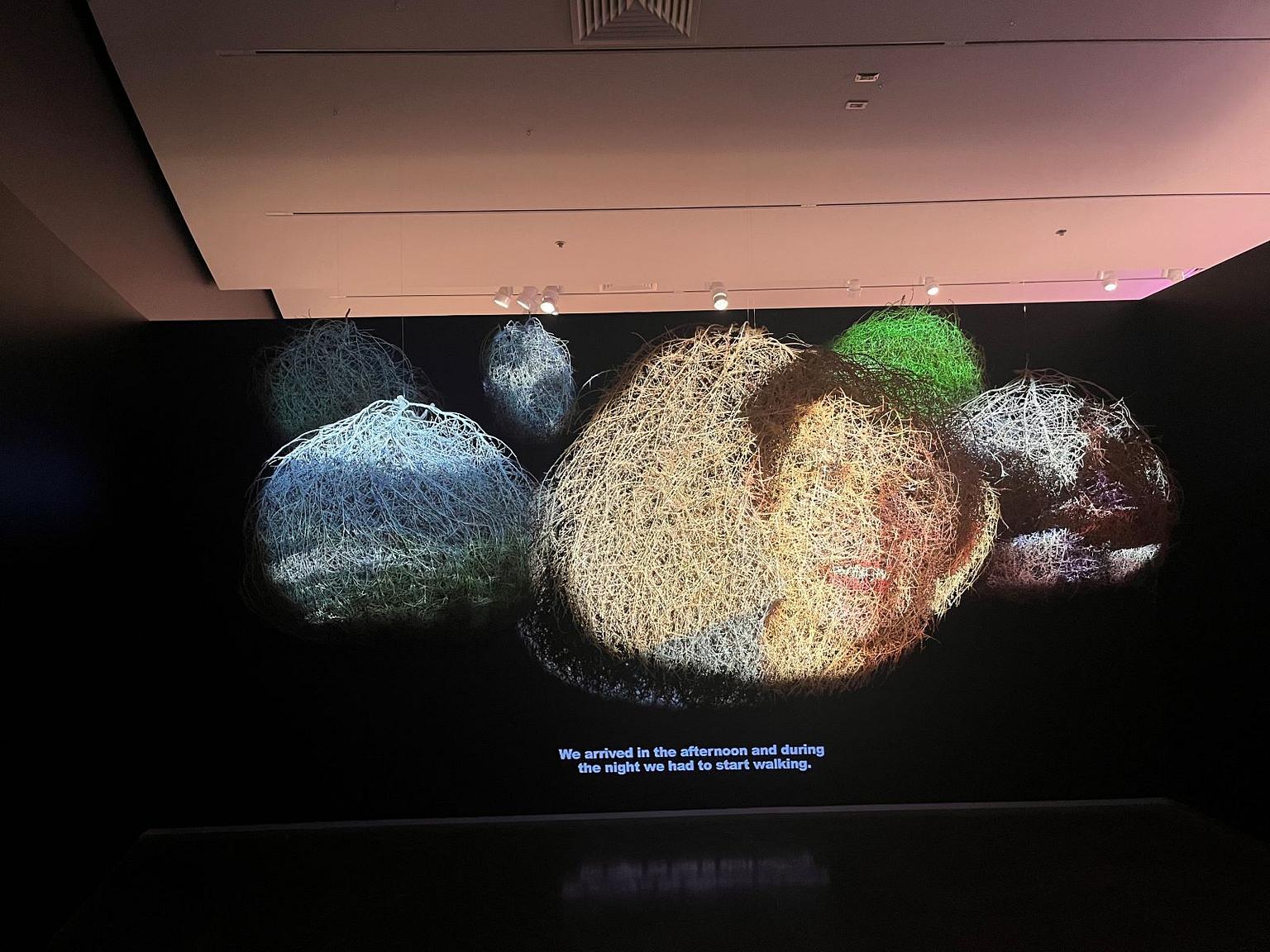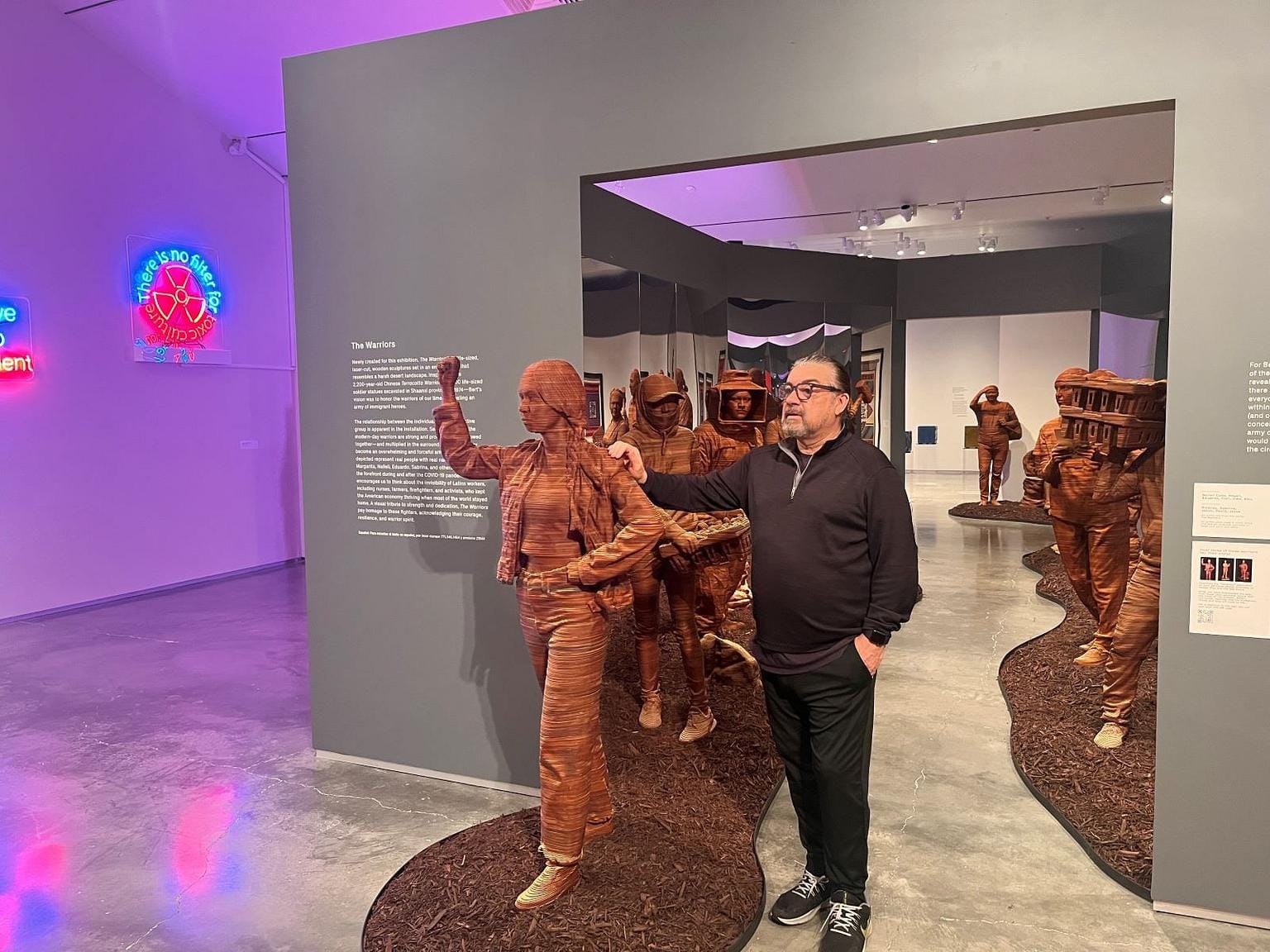Guillermo Bert: The Journey
Nevada Museum of Art
Reno, Nevada
Through Feb. 4, 2024
Guillermo Bert says all of his art starts with an idea, a concept. From there, he figures out the best way to represent that idea.
The result of his most recent effort is a mismatched catalogue of mixed media that includes gold-leaf barcodes, shiny plastic boxes with QR codes stamped onto them, and tumbleweeds that double as projection screens.
Through the tour, I was able to get sense of how the humor and political messages of the art only reflect the artist himself. I was lucky enough to go on a tour of the exhibit with Bert and curator Vivian Zavataro.
Two pieces stood out for me; both revolve around Latino immigrants to the United States. Bert himself immigrated from Chile in the ’80s.
“Tumble Dreams” featured six large, dense tumbleweeds that act as projection screens for the firsthand stories of immigrants who crossed the U.S.-Mexico border in search of a better life. Bert collected the spindly weeds himself from highway roadsides. Hung in the center, the biggest weed shows one immigrant at a time telling their story to the camera. Within the theater setup, viewers can also hear the person’s voice or read subtitles at the base of the wall behind the tumbleweeds. Two slightly smaller weeds flank the center one. Both show short videos of transportation infrastructure in constant motion, like cars at a border checkpoint. Three smaller bushes hung above are set in a state of blurry flux.

Bert’s choices created two different feelings for me. One, the rough surfaces of the dry tumbleweeds beget grainy video quality. It gives the images a fuzzy, dreamy vibe. The audience can barely make out the images. It speaks to the unclear myths, legends, and futures that draw prospective migrants to “El Norte.” And the journey, the centering subject matter of the installation, is unpredictable and hazy. The choice of tumbleweeds also evokes the idealized American Wild West, where anything was possible but incredibly harsh.
Two, the organic structure of the tumbleweeds held its own explanatory power. Dead tumbleweeds are actually a system of seed dispersal. So, even as a part of the plant dies, the tumbling stems blown by the wind help seeds escape into new soils. Then, new organisms form and put down roots, just as folks who undertake dangerous journeys to start their own new lives. “Tumble Dreams” was the best example of how Bert uses a multimedia metaphor to tell a story about the United States.
Utilizing technology to tell stories in unique ways is another centerpiece of Bert’s work. With “The Warriors,” made specifically for this exhibition, Bert continues that conceptual drive. The “warriors” are the most imposing feature of the gallery. They are a group of life-sized laser-cut wooden sculptures of real Latino frontline workers, like delivery drivers and nurses, who helped us get through the deepest depths of the pandemic. Bert completed 3D scans of each person before using a laser to cut 550 layers of wood for each figure. Most of the group stands proudly in a mirrored hallway on a bed of brown mulch. Bert took inspiration from the Terracotta Army of the Qin Dynasty for this army of important laborers.
The result is a feeling of infinite stories and people. The same people that get us the products, food, and services we need when we need them. It’s a sudden multiplication of formerly invisible folks that we often fail to recognize when a package just magically shows up at our front door. Bert’s point is obvious and thought-provoking. Besides bringing this hidden workforce to life, the sculptures also act as monuments to the work itself. They feel important, like we’re meant to pause and reflect in front of them. By honing in on this specific group of people and sharing their humanity in a way we don’t normally experience, Bert encourages us to connect.
While Bert’s exhibition sometimes lacks aesthetic beauty and nuance, “The Warriors” and “Tumble Dreams” invite discussion and introspection. They’re art that you should sit with and get to know a little. A cursory gallery glance won’t capture their full meaning. Wrestle with the political messages and conceptual underpinnings of both pieces. You might see the people around you a little bit differently.
What’s on at the NMA: Local Pyramid Lake Paiute artist Ben Aleck has his own retrospective going on through Jan. 7. April Bey’s Atlantica, The Gilda Region continues until Feb. 4. Cannupa Hanska Luger interrogates cargo cults in vivid multimedia through June 2. Two other female painters, Elisheva Biernoff and Charlotte Skinner, have shows up as well ending in April and May, respectively.
What’s next for Bert: He’ll be a part of the DIVERSEartLA social justice-focused section of the LA ART FAIR Feb. 14 through 18.






